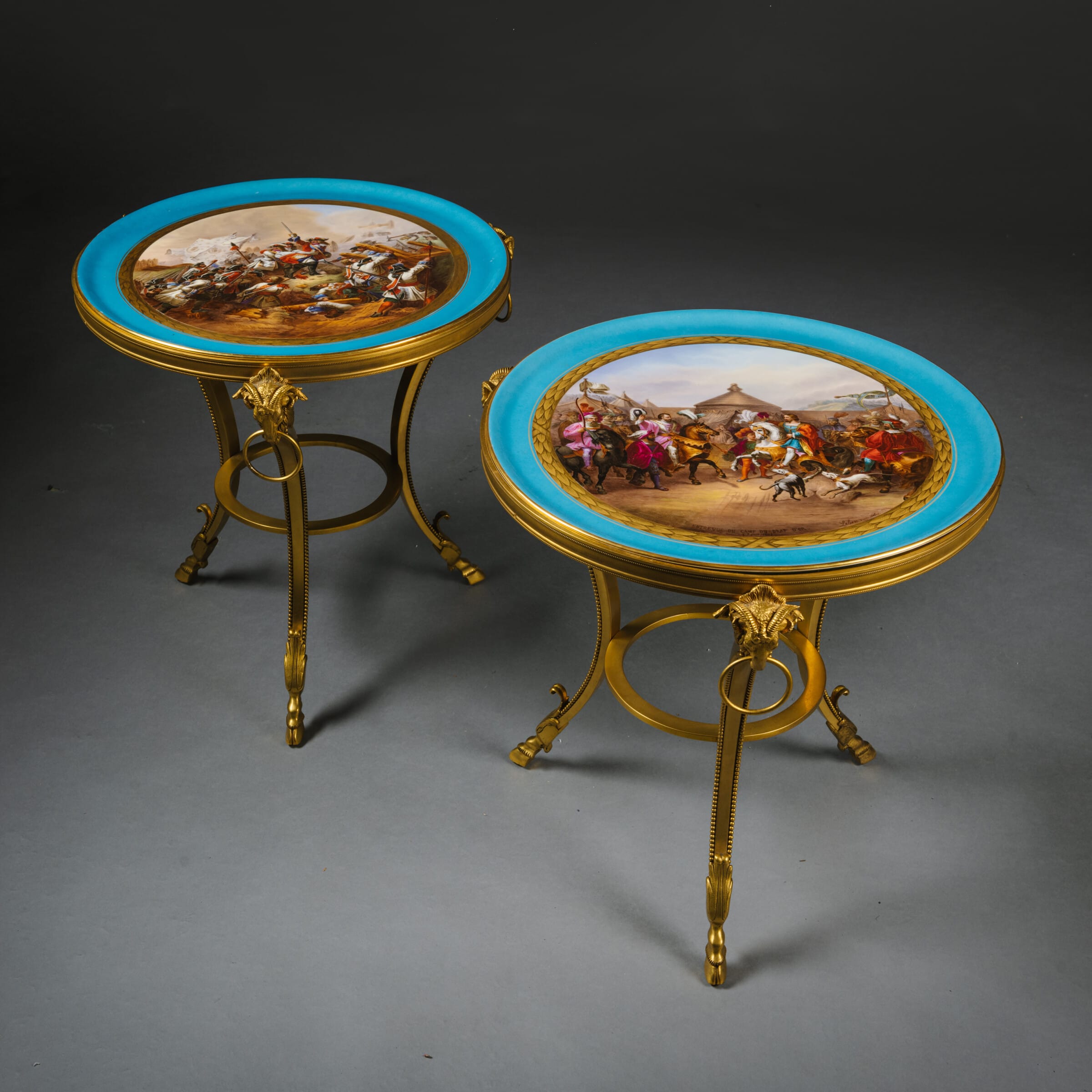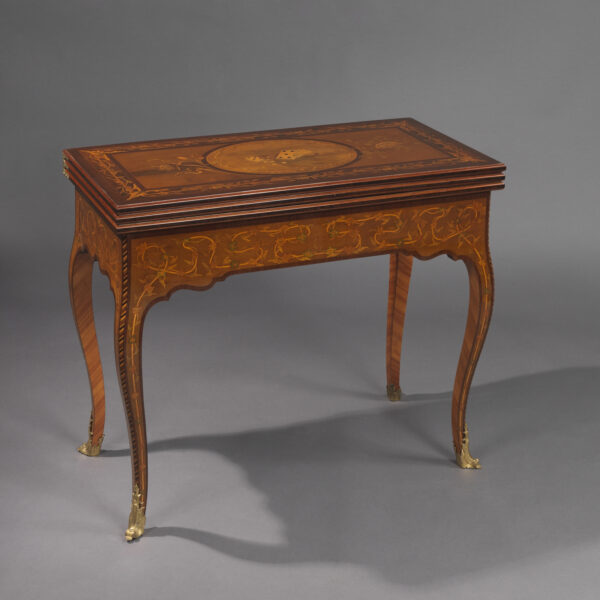سيفر (ستايل)
An Unusual Pair of Louis XVI Style Gilt-Bronze Low Side Tables With Sèvres-Style Porcelain Tops
£18,000
A Fine and Unusual Pair of Louis XVI Style Gilt-Bronze Low Side Tables With Sèvres-Style Porcelain Tops. Each table has a fine Sèvres-style porcelain...
ابعاد
Height: 49 cm (20 in)Diameter: 46 cm (19 in)
وصف
A Fine and Unusual Pair of Louis XVI Style Gilt-Bronze Low Side Tables With Sèvres-Style Porcelain Tops.
Each table has a fine Sèvres-style porcelain charger painted with historical battle scenes within bleu céleste borders supported on finely cast gilt-bronze tripod bases, the beaded legs headed by rams head masks and united by a circlet, terminating in acanthus and hoof feet.
The large and finely painted porcelain chargers are signed by the studio porcelain artist Leber and titled ‘Le Bataille de Denain’ (24 Julliet 1712) and ‘Entrevue du Camp du drap d’or’ (7 Juin 1520).
The Battle of Denain was fought on 24 July 1712 as part of the War of the Spanish Succession. It resulted in a French victory, under Marshal Villars, against Dutch and Austrian forces, under Prince Eugene of Savoy. The depiction by Leber is after the famous painting by Jean Alaux (1764-1894) in the Galerie des Batailles at the Palace of Versailles, exhibited at the Salon in 1839.

Jean Alaux (1764-1894) ‘‘Le Bataille de Denain’.
Photo (C) RMN-Grand Palais (Château de Versailles) / image RMN-GP
The Camp or Field of the Cloth of Gold is the name given to the famous diplomatic meeting which took place between King Francis I and Henry VIII of England from June 7 to 24, 1520, in the North of France, in Balinghem near of Calais. The depiction by Leber is after the painting by Auguste-Hyacinthe Debay (1804-1865), of 1837 now in the Place of Versailles.

Auguste-Hyacinthe Debay (1804 – 1865) ‘L’Entrevue du camp du Drap d’Or le 7 juin 1520’
Photo (C) RMN-Grand Palais (Château de Versailles) / image RMN-GP
The beauty of the tables lies principally in the finely painted scenes, which are painted with great delicacy and precision.
Each charger titled to the reverse and with spurious Sèvres marks.
الفرنسية، حوالي عام 1890.
تاريخ
حوالي عام 1890
أصل
فرنسا
متوسط
البرونز المذهب والخزف
توقيع
The porcelain chargers signed 'Leber' and titled to the reverse.
تأسس مصنع سيفر للخزف إلى الشرق من باريس في القصر الملكي المهجور في فينسين ، في أواخر 1739-40. وانتقل إلى قرية سيفر ، غرب باريس في عام 1756 ، في طريقه إلى قصر الملك لويس الخامس عشر في فرساي.
هنا كان أيضا مجاورا لقصر عشيقة لويس مدام دي بومبادور الخاص في بلفيو. كانت سعيدة بالموقع الجديد للمصنع - لأنها كانت تعرف أنها يمكن أن تغري لويس بالاهتمام به بشكل أكبر عندما يكون بالقرب من مساكنهم. في الواقع ، أصبح الملك راعيا متحمسا للمصنع لدرجة أنه عندما واجه صعوبات مالية ، اشترى المساهمين وأصبح المالك الوحيد. ظل المصنع مشروعا ملكيا حتى الثورة الفرنسية ، عندما تم تأميمه.
أدت شعبية أسلوب لويس الخامس عشر خلال القرن التاسع عشر إلى قيام عدد من الشركات في باريس وحولها بإنشاء خزف استثنائي على طراز سيفر يعتمد على نماذج القرن الثامن عشر وبنفس الجودة الاستثنائية. غالبا ما كانت هذه القطع ذات جودة وحجم المعرض ، وتم رسمها بدقة من قبل أفضل رسامي الاستوديو في ذلك الوقت مثل روبرت وديبريز وبويتفين.


















 طبع
طبع


